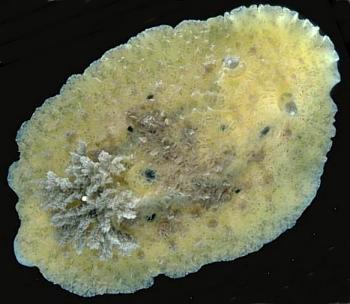
Sclerodoris apiculata
(Alder & Hancock, 1864)
Order: NUDIBRANCHIA
Suborder: DORIDINA
Superfamily: EUDORIDOIDEA
Family: Dorididae
DISTRIBUTION
Indo-West Pacific
PHOTO
Upper right, Lower left: Coffs Harbour Region, nthn New South Wales, Australia, Dec 1990. AM C164558. Lower right: Close-up of papillae.AM C133277. PHOTOS: Bill Rudman.
Usually a dull, brown or yellowish colour, with a firm, sponge-like mantle. Characterised by the the extensible papillae which are attached to the tips of scattered tubercles. The larger tubercles (see LOWER RIGHT) can have secondary papillae. The papilla are fluid filled and because they can be fully retracted, there is sometimes no sign of them in preserved animals.
References:
• Alder, J. & Hancock, A. (1864) Notice of a collection of Nudibranchiate Mollusca made in India by Walter Elliot, Esq., with descriptions of several new genera and species. Transactions of the Zoological Society of London 5: 113-147.
• Rudman, W.B. (1978) The dorid opisthobranch genera Halgerda and Sclerodoris from the Indo-West Pacific. Zoological Journal of the Linnean Society 62: 59-88.
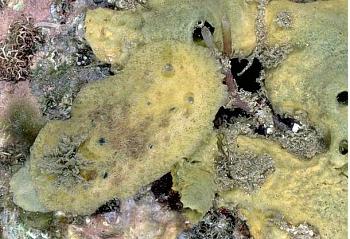
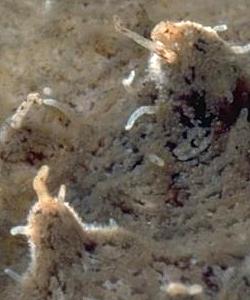
Rudman, W.B., 2001 (February 6) Sclerodoris apiculata (Alder & Hancock, 1864). [In] Sea Slug Forum. Australian Museum, Sydney. Available from http://www.seaslugforum.net/find/scleapic
Related messages
Sclerodoris apiculata from Heron Island
February 18, 2009
From: Julie Marshall
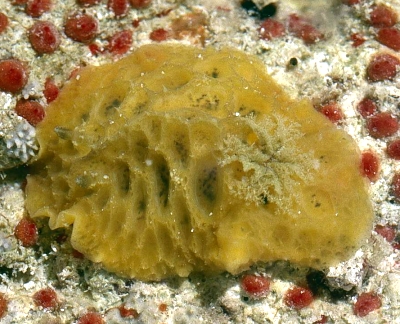
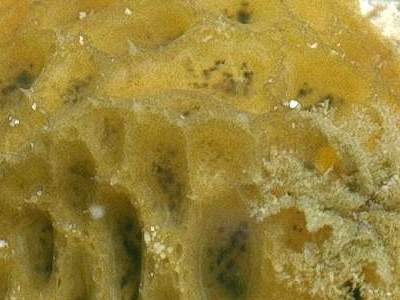
Concerning message #22249:
Dear Bill,
Attached is a photo of Sclerodoris apiculata from Heron Island [Great Barrier Reef] following the message of Hugo Flodrops of a similar animal from Reunion Island. It was found at the reef crest at low tide under a dead coral slab and was 40 mm in size. I'm also sending a photo which, although unfortunately blurred, does show the dull yellow undersurface of the mantle and foot.
Locality: Heron island, Intertidal, Queensland, Australia, Pacific, January 1994, Intertidal. Length: 40 mm. Photographer: Julie Marshall.
Best wishes,
Julie Marshall
juliegm@gmail.com
Marshall, J.G., 2009 (Feb 18) Sclerodoris apiculata from Heron Island. [Message in] Sea Slug Forum. Australian Museum, Sydney. Available from http://www.seaslugforum.net/find/22260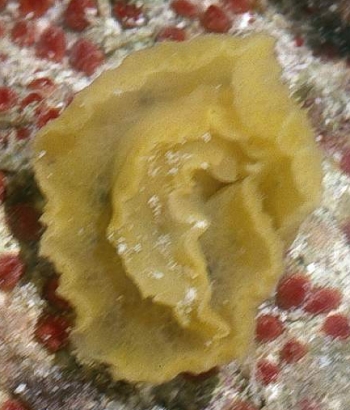
Thanks Julie,
I've included a close-up of the mantle to show the half-extended, pointed papillae arranged along the ridges. As you know, these papillae are characteristic of the species.
Best wishes,
Bill Rudman
Aldisa sp ? from Reunion Island
February 12, 2009
From: Hugues Flodrops
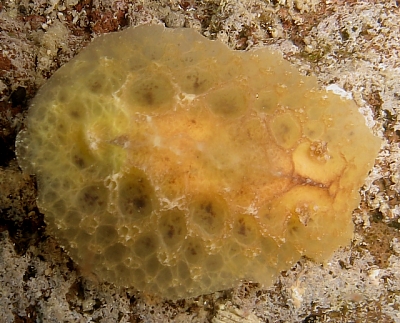
Concerning message #6124:
Hi Bill,
Here is another nudibranch which I think is a kind of Aldisa? In the two pictures, we can see the brown gills appearing in the side view [middle left photo]. I can't find any similar picture on the forum or inside my reference books. Can you help us a new time.
Locality: Etang-Salé "Permanent Pool", 2 metre, Reunion Island, Indian Ocean, 5 december 2007, Night. Length: 40 mm. Photographer: Hugues Flodrops.
Regards.
Hugues.
hugues.flodrops@wanadoo.fr
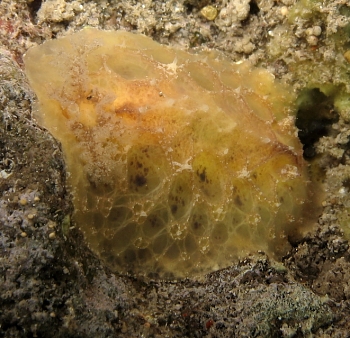
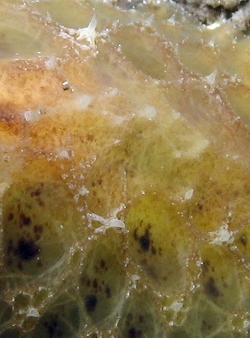

Dear Hugues,
I am glad you included the second photo as I was beginnin to wonder if you had sent a photo of a sponge or ascidian colony. It is a well-camouflaged slug! In that second photo I could see not only the gills beginning to emerge but a number of white papillae at the junctions of the ridges on the mantle. I am pretty sure your animal is Sclerodoris apiculata. Fortunately some of the papillae were visible, because often when disturbed - such as when being photographed and examined by humans - all the papillae retract and the slug is indistinguishable from a number of other well camouflaged species.
Best wishes,
Bill Rudman
Sclerodoris apiculata from Townsville, Queensland
August 23, 2007
From: Melanie Wood
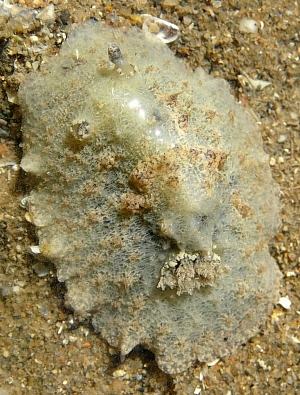
Hi,
I found this species of Sclerodoris apiculata attached to the underside of a rock (which it consequently fell off after it was disturbed). While I was observing it I noticed a behaviour which I found to be unusual - it was lifting or rolling the front of the mantle up and coming forward or 'lunging' slightly though I do not know what at. I did capture a couple of photos of this, but they have not turned out too well. The last time I found the same species it was much more yellow then this specimen but I still think it is lovely.
When looking at the larger picture I thought that the 'tapering papillae' were rather cool.
Locality: Rowes Bay, Townsville, 0.39 metres, Queensland, Australia, 10 August 2007, Intertidal muddy area. Length: 7 cm. Photographer: Melanie Wood.
Melanie Wood
melanie.wood@jcu.edu.au
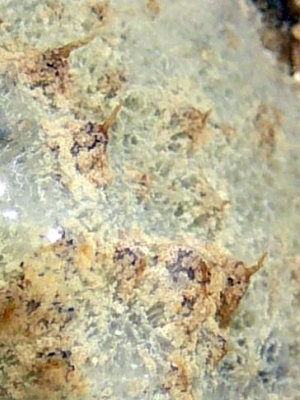
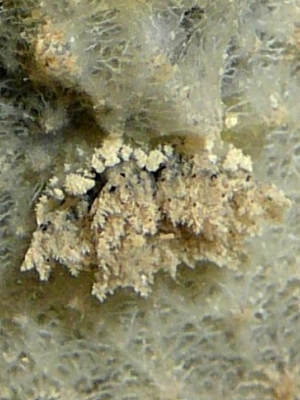
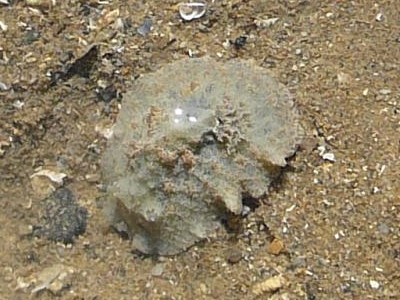
Dear Mel,
Thanks for this record. The tapering papillae are its most characteristic feature, and when disturbed they can completely retract. Which means that identifying them from preserved specimens can be tricky. I haven't included your photo of the mantle lifting up at the front but the animal does this in very shallow water because it 'feels' the water surface as a 'surface' it can crawl on. If you put it in a dish of water it will crawl up the sides until it reaches the water surface and then crawl out upside down on the underside of the surface film. I don't think they do it for adaptive reasons, I think it is just a reflex response to a sooth surface. Often at low tide you will find nudibranchs and small snails in sheltered pools crawling like this, suspended upside down.
Best wishes,
Bill Rudman
Sclerodoris apiculata from Reunion Island
March 24, 2007
From: Philibert Bidgrain
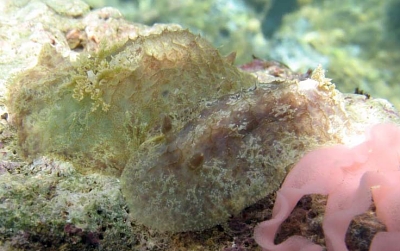
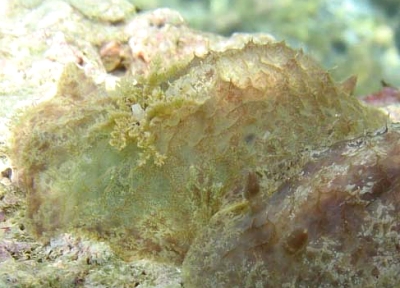
Dear Bill,
Reunion Island seaslugs
These specimens look like Sclerodoris apiculata with "the extensible papillae which are attached to the tips of scattered tubercles". In one of the photo we can see a pink spawn found under the same rock of the two specimens.
Locality: Etang Sale les Bains, Less 1 m, Reunion Island, Indian Ocean. Length: 30-40 mm. Photographer: Philibert Bidgrain.
Could it be their spawn?
What's your opinion about this identification?
Philibert Bidgrain
http://vieoceane.free.fr/runseaslug/indexslug.htm
pbidgrain@yahoo.fr
Bidgrain, P., 2007 (Mar 24) Sclerodoris apiculata from Reunion Island. [Message in] Sea Slug Forum. Australian Museum, Sydney. Available from http://www.seaslugforum.net/find/19689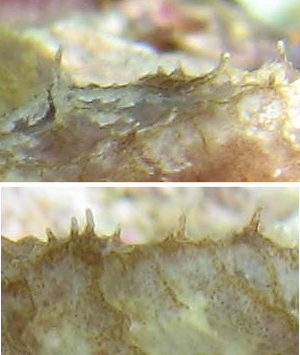
Dear Philibert,
Yes this is S. apiculata, and I am pretty sure I found pinkish colour egg ribbons from animals in Tanzania, but I will need to check my notes. One problem with identifying this species is that the characteristic papillae retract back into the skin so in most preserved specimens there are no indications of them.
Best wishes,
Bill Rudman
Sclerodoris apiculata from Saudi Arabia
February 8, 2001
From: Gordon T. Smith
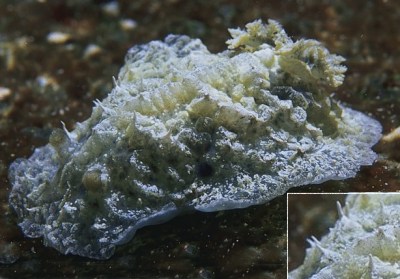
Dear Bill,
This one has got me stumped, although I am sure if I looked hard enough I will find a reference somewhere. Any Ideas ?
About 4 cm long at 2 metres on Blue Beach, North Obhur, Jeddah (Saudi Arabia, Red Sea)
Regards
Gordon
aquashot@emirates.net.ae
Smith, G.T., 2001 (Feb 8) Sclerodoris apiculata from Saudi Arabia. [Message in] Sea Slug Forum. Australian Museum, Sydney. Available from http://www.seaslugforum.net/find/3641Dear Gordon,
This is Sclerodoris apiculata. One of a number of dorids which are camoufaged to look like a lump of sponge. The long tapering papillae at the tip of many of the tubercles are a good character of this species.
Bill Rudman
